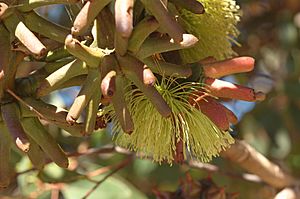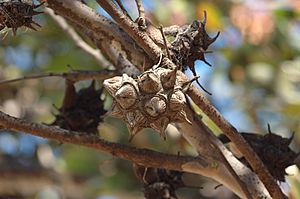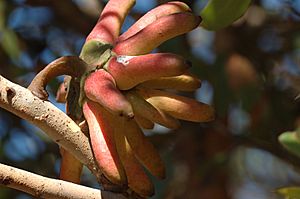Bald Island marlock facts for kids
The Bald Island marlock, also called bushy yate, is a special kind of Eucalyptus tree. Its scientific name is Eucalyptus conferruminata. This small tree or bushy plant only grows naturally along the south coast of Western Australia. It has smooth, light-colored bark. Its leaves are shaped like eggs. Its flowers are green or yellowish and grow in cool, fused groups. The fruits also grow together in a woody clump.
Quick facts for kids Bald Island marlock |
|
|---|---|
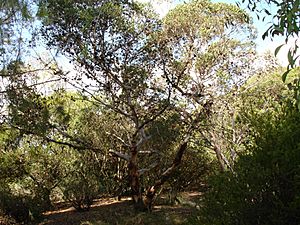 |
|
| Eucalyptus conferruminata, Melbourne | |
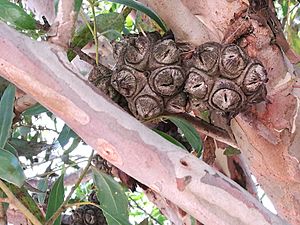 |
|
| Fruit: Cranbourne Botanic Gardens | |
| Scientific classification | |
| Genus: |
Eucalyptus
|
| Species: |
conferruminata
|
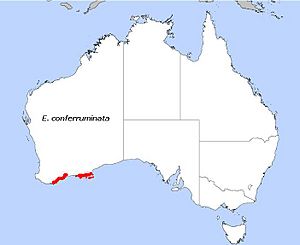 |
|
| E. conferruminata, field distribution | |
Contents
What Does the Bald Island Marlock Look Like?
This plant can be a small tree or a bushy shrub. It usually grows between 2 to 8 metres (7 to 26 ft) tall. Its bark is smooth and has shades of grey and white.
Leaves, Flowers, and Fruits
The adult leaves are shiny and light green. They are shaped like an oval or an egg. These leaves are about 40–90 mm (1.6–3.5 in) long and 10–30 mm (0.39–1.18 in) wide.
The flower buds are quite unique. They grow in groups of 15 to 21 or more. These buds are joined together at their base. The top part of the bud is free and looks like a horn.
Green to yellow-green flowers bloom from late winter to late spring. This is usually between August and November. After flowering, the fruits also grow together. They form a woody clump about 14–26 mm (0.55–1.02 in) wide. The seeds are released through small gaps in this woody mass.
How Was the Bald Island Marlock Named?
Scientists Denis John Carr and Stella Grace Maisie Carr first officially described this plant in 1981. They published their findings in the Australian Journal of Botany.
Meaning of the Name
The scientific name conferruminata comes from a Latin word. It means "fused" or "joined together". This name was chosen because the plant's flower buds and fruits are often fused.
Different Types of Bald Island Marlock
In 2008, some other botanists found two slightly different types of E. conferruminata. These are called subspecies.
- Eucalyptus conferruminata subsp. conferruminata: This type has a wider horn-shaped part on its flower bud.
- Eucalyptus conferruminata subsp. recherche: This type has a narrower horn-shaped part on its flower bud.
Where Does the Bald Island Marlock Grow?
This plant naturally grows in the south of Western Australia. You can find it from Two Peoples Bay all the way east past Esperance. It also grows on islands in the Recherche Archipelago.
Its Favorite Places to Grow
The Bald Island marlock always grows near the coast. It often grows on large granite rocks. You can also find it on hillsides and in small valleys. It prefers sandy-loamy soils that are on top of granite or quartzite rock.
Where Else Can It Be Found?
This plant has also started growing in other parts of Western Australia. This happened because people planted it for projects like windbreaks. Sometimes, seeds from garden plants also spread.
It has also started growing in Victoria, in the Gippsland and Wimmera areas. This happened after seeds spread from planted trees. The Bald Island marlock has even become naturalized in California, USA.
The subspecies recherche is often grown in gardens. It is common in coastal areas of southern Australia, like Perth and Adelaide. The subspecies conferruminata only grows naturally on the islands of the Recherche Archipelago. It does not grow on the mainland.
Why Is This Plant Useful?
The Bald Island marlock is sold as an ornamental plant. People also use it to create windbreaks. It is good for stopping soil erosion.
This plant is quite tough. Once it is established, it can handle drought conditions. It can also tolerate moderate frost. It grows well in many different soil types, even soils that are very wet.
See also
 In Spanish: Marlock de la Isla Bald para niños
In Spanish: Marlock de la Isla Bald para niños


